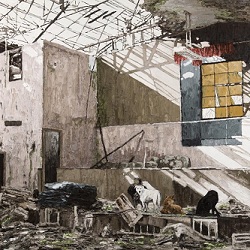
The paintings of Matt Bahen are nothing if not quiet. That is not to say that they do not speak to us, directly and clearly; they do, but in hushed voices, as if imparting a secret. It might be easy to overlook such work -- simple, almost monochromatic paintings of derelict landscapes -- were it not so good.
Bahen's subjects are ruined places: empty industrial buildings, Anselm Kiefer-ish woods, and frozen, snowy rivers. It would be more precise to say that these are Bahen's locations; his real subject matter is paint. In "The August of the Night" (2012 [left]) and "In the Quiet of the Dark" (2012), Bahen uses the plays of light, gliding through empty spaces and tracing rectangular windowpane patterns on the walls to exercise a muscular brush, loading heavily leaded pigment layer by layer -- essentially sculpting that most fleeting thing, light, out of dense pigments.
There is, of course, a lineage here; Baher is following Courbet, Corot, Auerbach, and Kossoff, as well as the vast panoramas of Kiefer's Scorched Earth landscapes. In "The August of the Night," there is a nod to Kiefer's sculpture in the pile of industrial metal stacked in the forefront of the picture. But Bahen is not blindly following a road where others have done the paving. He teases the paint, building it up thickly, playing with the reflective and refractive properties of its colors and pigments, allowing the viewer to gather a sense of light playing off surface -- from a distance -- yet seeing the paint as object, up close. This sense play is almost Impressionistic (sans primary colors), but it possesses much more gravitas than most plein air works of parks and fields.
From the early experiments of Cubism onward, most painting (particularly that of the abstract variety) sought to navigate the dynamics of the tangible in an attempt to show the timeless and transcendent through the medium; still, Rothko, Newman, et al. created metaphysical landscapes, more or less, through paint. In his paintings -- such as "The Crossing" (2012), a vast frozen lake dusted with fluffy snow, and "The Weight of Light" (2012), a haunted stand of trees, iced over -- Bahen uses the play of lights and darks in an almost abstract construction of dynamic line and empty space; the trees are reminiscent of Kline, and the lake resembles a late-period Clyfford Still.
Adorno wrote, "As the work, under the auspices of modernism, posits unintelligibility as expression, increasingly destroying its intelligible moment, the traditional hierarchy of understanding is shattered. Its place is taken up by reflection on the enigmatic qualities of the art...." Bahen obviates a century of Modernist work here, letting paint exist in service to picturing "the world" -- not in the AbEx sense of reflecting metaphysical mysteries of abstract symbols, but the more enigmatic reality of picturing the endless possibilities of light.
Munch Gallery is at 245 Broome Street (at Ludlow Street), New York, New York.
